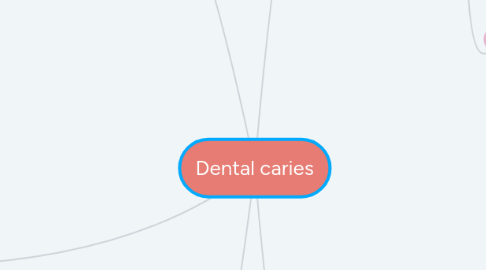
1. Pathology
1.1. Macroscopic
1.1.1. Opaque chalky white or brown spot
1.2. Histo pathology
1.2.1. Enamel
1.2.1.1. Initiation
1.2.1.1.1. Translucent zone
1.2.1.1.2. Dark zone
1.2.1.1.3. Body of the lesion
1.2.1.1.4. Surface layer
1.2.1.2. Bacterial invasion phase
1.2.1.3. Destruction phase by proteolytic enzymes
1.2.1.4. Secondary enamel caries phase(bluish-white)
1.2.2. Dentin
1.2.2.1. Uninfected dentin(acid attack)
1.2.2.2. Dentinal destruction(superficial zone)
1.2.2.3. Infected dentin(bulk of the lesion)
1.2.3. Root surface
2. Definition
2.1. Microbial disease in the hard tooth structure leads to demineralisation and destruction of the tooth substances
3. Dental plaque
3.1. Definition
3.1.1. It’s a tenacious structure on tooth surface (biofilm)
3.2. Composition
3.2.1. Microorganisms in amorphous matrix of proteins,carbs and inorganic content
3.3. Factors
3.3.1. Anatomy and position of tooth
3.3.2. Presence of appliance
3.3.3. Structure of tooth
3.3.4. Friction
3.3.5. Oral hygiene measures
3.3.6. Composition of diet
3.4. Mechanism
3.4.1. 0-4hr:formation of enamel pellicle and attachment of single bacterial cells
3.4.2. 4-24hr :growth of attached bacteria then formation of micro colonies
3.4.3. 1-14days:microbacterial succesion and co-aggregation
3.4.4. 2 weeks or more : climax community and mature plaque
4. Types
4.1. Site
4.1.1. Smooth surface
4.1.2. Pits and fissures
4.1.3. Root cavity
4.2. Stage
4.2.1. Spot
4.2.2. Enamel caries
4.2.3. Dentin caries
4.2.4. Deep dentin caries
4.3. Rate
4.3.1. Rampant
4.3.2. Acute
4.3.3. Chronic
4.3.4. Arrested
5. Etiology
5.1. Host factors
5.1.1. Susceptible tooth
5.1.1.1. Position
5.1.1.1.1. More in lower/posterior/malaise’s teeth
5.1.1.2. Morphology
5.1.1.2.1. More in pits and fissures/ contact area
5.1.1.3. Structure
5.1.1.3.1. Teeth with enamel hypoplasia or hypo calcification or newly erupted tooth more susceptible.
5.1.1.4. Fluorides
5.1.1.4.1. Increase the resistance to enamel caries.
5.1.1.5. Genetic factors
5.1.1.5.1. Tooth morphology is genetically inherited
5.1.2. Saliva
5.1.2.1. Washing effect
5.1.2.2. Degree of viscosity
5.1.2.3. Buffering capacity
5.1.2.4. Antibacterial effect
5.2. Fermentable carbs
5.2.1. Types
5.2.1.1. Monosaccharides
5.2.1.1.1. Less than disaccharides
5.2.1.2. Disaccharides
5.2.1.2.1. More cariogenic
5.2.1.3. Polysaccharides
5.2.1.3.1. Least cariogenic
5.2.2. Frequency on intake
5.2.3. Texture
5.2.3.1. Sticky carb is more cariogenic
5.2.4. Local effect of carbs
5.2.5. Refinement
5.2.6. Amount of intake
5.3. Cariogenic bacteria
5.3.1. Criteria
5.3.1.1. Acidogenic
5.3.1.2. Acidouric
5.3.1.3. Formation of EC polysaccharides
5.3.1.4. Able to transport fermentable sugers
5.3.1.5. Formation and utilisation of IC polysaccharides
5.3.1.6. Have attachment mechanism
5.3.2. Examples
5.3.2.1. Lactobacillus species
5.3.2.1.1. Cause pits and fissure caries
5.3.2.2. Streptococcus mutans
5.3.2.2.1. Cause smooth surface caries
